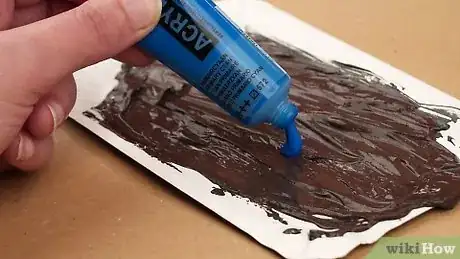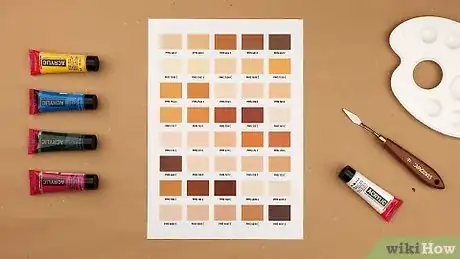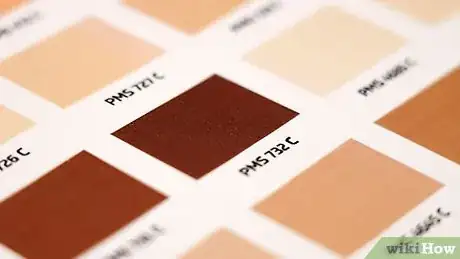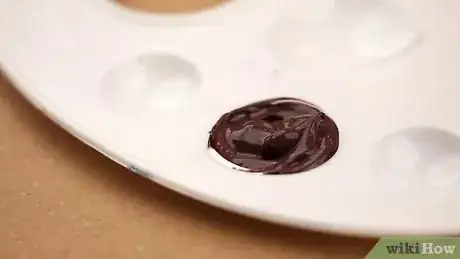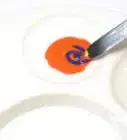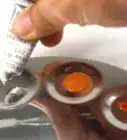This article was co-authored by Kelly Medford and by wikiHow staff writer, Aly Rusciano. Kelly Medford is an American painter based in Rome, Italy. She studied classical painting, drawing and printmaking both in the U.S. and in Italy. She works primarily en plein air on the streets of Rome, and also travels for private international collectors on commission. She founded Sketching Rome Tours in 2012 where she teaches sketchbook journaling to visitors of Rome. Kelly is a graduate of the Florence Academy of Art.
There are 11 references cited in this article, which can be found at the bottom of the page.
This article has been viewed 3,272,975 times.
Brown. It may be a plain word, but it covers a wide variety of shades, hues, and blends. But how can you add this versatile color to your painting palette if you don’t have a tube of brown paint? Well, there are a number of ways you can mix paint colors to make brown—from combining primary colors to mixing complementary colors. In this guide, we’ll teach you how to make brown paint and change its value, saturation, and hue. Grab your palette and paints because we have some color mixing to do!
Things You Should Know
- Combine equal parts of red, yellow, and blue (the primary colors) to create a basic shade of brown.
- Mix orange and blue or red and green together to make brown out of secondary colors.
- Use complementary colors, like blue and orange, red and green, or yellow and purple, to create different tones of brown.
Steps
Using the Color Wheel to Make Brown
-
1Mix equal parts of red, yellow, and blue to make brown. Red, yellow, and blue are primary colors on the color wheel and can be used to make a variety of colors, including brown. This is the simplest and easiest way to make a brown color palette out of paints you already have. Just add equal amounts of each color to your palette and mix them with a palette knife or paintbrush.[1]
- Using a limited palette with just primary colors and white can be a great way to understand how color mixing works and how many colors you can get from just a few colors.
- Experiment with colors and they ratios. You can use different amounts of each color to change the hue of your brown paint. For instance, adding more blue and yellow will make a greenish brown.
- In painting, hue refers to a specific gradation or tint of color.[2]
-
2Combine orange and blue or red and green to create brown. Secondary colors are made by mixing 2 primary colors together. Stirring a primary and secondary color together can help you make multiple shades of brown and is helpful if you have individual tubes of pre-mixed paint to work with.
- Here’s how you can make secondary colors with primary colors:
- Blue + red = purple
- Blue + yellow = green
- Yellow + red = orange
Advertisement - Here’s how you can make secondary colors with primary colors:
-
3Blend yellow and purple together. On the color wheel, these are known as complementary colors. The colors are opposite of each other on the wheel, and when mixed together, result in a murky brown. Use equal parts of the 2 colors or more or less of 1 color to change the brown color’s hue.
- Each complementary pairing will create a different hue of brown when mixed, so don’t be afraid to experiment until you find the perfect color.
Creating Shades of Brown
-
1Add white or black to your brown paint to change the value. In painting, value is the overall brightness of a color in terms of light and dark.[3] Mixing more white into a brown paint will make it a lighter shade, whereas adding more black makes it darker.[4]
- For example, if you want to make a tannish light brown, mix half of a yellow-tinted brown paint with equal parts of white paint.
- To make a dark, mud-like brown, gradually add black paint to a green-tinted brown.
- Keep in mind that adding dark to light is easier than adding light to dark, so always use a delicate hand when changing the value of a color.
-
2Use more primary and secondary colors to change the hue of the paint. The more of one color you add while mixing paint, the more that single color will shine through. For instance, if you created brown using blue and orange paint, you can give the paint warmth by adding red to the mixture. To make a dark, murky brown, you could add purple or green.[5]
- Test out a hue change by mixing a small amount of brown with a tiny amount of another color on a separate palette. This way, you can experiment until you find the right shade.
- Add tertiary colors (combinations of primary and secondary colors, such as blue-green, red-orange, and yellow-green) for a more subtle hue change.
-
3Mix in gray or additional primary or secondary colors to alter the saturation. The saturation of a paint color refers to its overall richness and vibrancy. Something with high saturation will be bold and bright, whereas something with low saturation has a grayish hue.[6] To make your brown paint brighter, add more of the original colors you mixed together. For a grayer tone, mix in a bit of gray paint.[7]
Using a Pantone Guide
-
1Obtain a Pantone Formula Guide. Primarily used in the printing industry, Pantone color guides provide precise color references to help you find a particular shade of brown. These guides can be super helpful for avid painters and can be purchased new or used online.[11]
- Know that Pantone defines colors in a CMYK (Cyan, Magenta, Yellow, and Black) color space rather than an RGB (Red, Green, and Blue) color space. White is not included in the color palette because that’s typically the color the palette is printed on.
-
2Locate the brown you want on the guide. There are several cards to flip through in a Pantone guide, so focus on pulling cards with shades of brown in your ideal hue. For instance, pull a magenta card if you want a brown with red or purple undertones or a card with beige tones if you want to replicate a skin color.
-
3Mix your paints following the proportions on the guide. Once you find the color you’re looking for, use the proportions and/or formula provided on the Pantone guide to mix a nearly exact replica of the color. Use a scale or a measuring utensil to get a precise amount of each paint color.[12]
- This may not be the most accurate way to create brown paint, but it can help you learn which colors to mix to achieve a certain shade or hue of brown.
Community Q&A
-
QuestionWhat color do I use to turn white into brown?
 Community AnswerTry a little bit of black depending on how dark you want it, green, and yellow. Keeping adding until you get a color you like.
Community AnswerTry a little bit of black depending on how dark you want it, green, and yellow. Keeping adding until you get a color you like. -
QuestionHow can you turn caramel into a darker brown?
 Community AnswerMix red and green separately to form a dark brown, then add it to the caramel color until you get the shade you want.
Community AnswerMix red and green separately to form a dark brown, then add it to the caramel color until you get the shade you want. -
QuestionWhat other colors can I make?
 Community AnswerDepends on what colors you have to begin with. Typically, red, yellow, and blue are the primary colors used to make all other colors, along with white for lightening and black for darkening. You can try experimenting with these basic colors to figure out what combinations of them result in what colors. Or you can always search up online how to make a specific color.
Community AnswerDepends on what colors you have to begin with. Typically, red, yellow, and blue are the primary colors used to make all other colors, along with white for lightening and black for darkening. You can try experimenting with these basic colors to figure out what combinations of them result in what colors. Or you can always search up online how to make a specific color.
References
- ↑ http://helloartsy.com/palette-knife/
- ↑ https://www.moma.org/learn/moma_learning/glossary/#h
- ↑ https://www.virtualartacademy.com/three-components-of-color/
- ↑ https://www.mybluprint.com/article/11-hacks-for-mixing-acrylic-paint-perfectly
- ↑ http://www.elizabethreoch.com/mixing-paint-colours-what-colours-make-brown/
- ↑ https://www.virtualartacademy.com/three-components-of-color/
- ↑ http://www.sensationalcolor.com/understanding-color/theory/color-relationships-primary-secondary-tertiary-hues-1842#.XB1leVxKjIU
- ↑ https://youtu.be/UwT6ZPl65cM?t=6
- ↑ https://youtu.be/IXMMa_lrcIw?t=12
About This Article
If you want to mix paint colors to make brown, mix all of the primary colors together, which are blue, yellow, and red. You can also mix 2 complementary colors together to make brown, like blue and orange, red and green, or yellow and purple. If you want your brown paint to be lighter, mix it with a little bit of white. If you want it to be darker, mix it with some black paint. To change the hue of your brown paint, add red to make it warmer, or purple and green to make it cooler. If you want to learn how to make your paint seem brighter or duller, keep reading!
